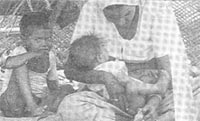Childish foibles
 CONTAMINATION of weaning food and water, mother's nails and teats, improperly cleaned utensils and feeding bottle nipples are responsible for a high incidence of infantile diarrhoea in Chandigarh, suggests a study. Conducted by researchers of the Government Home Science College, Chandigarh, this study on the major modes of transmission of the culprit bacterium - Escherichia coli - brings to light the high vulnerability of children from low income groups (LIG) Of the city to the dreaded disease (Indian Paediatrics, Vol 32, No 5).
CONTAMINATION of weaning food and water, mother's nails and teats, improperly cleaned utensils and feeding bottle nipples are responsible for a high incidence of infantile diarrhoea in Chandigarh, suggests a study. Conducted by researchers of the Government Home Science College, Chandigarh, this study on the major modes of transmission of the culprit bacterium - Escherichia coli - brings to light the high vulnerability of children from low income groups (LIG) Of the city to the dreaded disease (Indian Paediatrics, Vol 32, No 5).
Say A Ghuliani and M Kaul of the Government Home Science College, Chandigarh, "The present study was undertaken to gain insight into sources of contamination of weaning food as also various modes of transmission of E coli into the child's body and their role in causing infantile diarrhoea."
Nearly 534 samples of weaning food, water, utensils, swab samples of child's milk bottle and mother's nails were collected from 100 randomly selected LIG families - those with monthly income less than Rs 2,000 - of the union territory. Subject to the consent of the mother, swab saLnples of mother's teats and the child's hands were also analysed for the presence of E coli.
Researchers found a high incidence of infantile diarrhoea among the families surveyed. "E coli isolation of the order of 80.9 per cent was observed in 80 of the 100 house holds where infants have a diarrhoeal history. About 38 per cent E coli isolation was observed in households without any history of infantile diarrhoea. And only 2 households were found without any history of the disease and E coli isolation," say Ghuliani apd Kaul.
And about 80 per cent of children suffered from diarrhoea even when being breast fed, which may be due to the mothers' lack of knowledge regarding personal hygiene.
